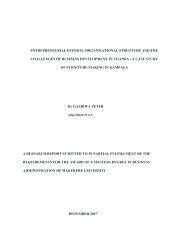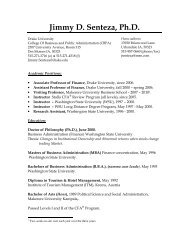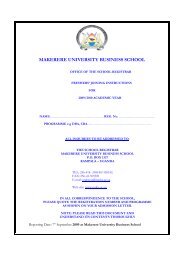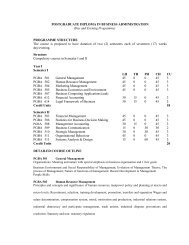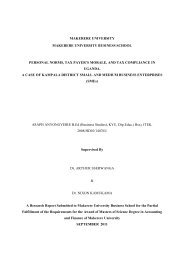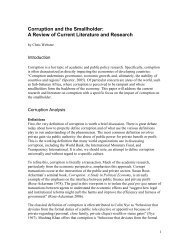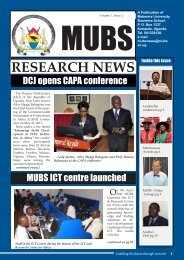13th Annual International Management Conference Proceeding
13th Annual International Management Conference Proceeding
13th Annual International Management Conference Proceeding
Create successful ePaper yourself
Turn your PDF publications into a flip-book with our unique Google optimized e-Paper software.
John Adair highlighted the importance of a leader being able to balance the needs of the task, the team and the<br />
individual (1973).<br />
From the late 1970s onwards the concept of ‘transformational leadership’ gained currency with writers like Burns<br />
(1978) and later Covey (1992) advocating that leadership should be about transforming people and organizations by<br />
engaging their hearts and minds or what Eric Garner calls the Pygmalion effect (treat a man as he is and he will remain as<br />
he is and treat a man as he can or should be and he will become as he can or should be).<br />
Other leadership theories have emphasized the importance of the ‘charismatic leader’ or the ‘servant leader’ particularly<br />
in the last 20 years (Greenleaf 1998). Others have highlighted the spiritual dimension of leadership (Owen 1999;<br />
Kakabadse and Kakabadse 1999) or what Wabala calls the heart of a servant leader 5 . These ideas have been<br />
complemented by recent work on ‘distributed leadership’, based on the notion of leadership being first and foremost a<br />
relationship of mutual influence between leaders and followers. The ‘followership’ of an organization or business entity,<br />
and how freely they attribute leadership authority, is also increasingly recognized as having an important role to play in<br />
the behavior and success of a leader (Howell and Shamir 2005).<br />
Good as this review may be, it suffices that almost all this leadership theory is based on a very specific context – Western<br />
management of private sector companies. As a result much of the current leadership research is not relevant to the<br />
different contexts in which small businesses operate or work given the great dynamism (Smillie and Hailey 2001;<br />
Fowler, Ng’ethe and Owiti 2002; Hailey and James 2004). While these studies have increased our understanding of the<br />
static characteristics of effective leadership within small organizational settings, few have tried to explore the dynamics of<br />
how leaders change and develop within small enterprises that might have either just one or two people. Yet as social<br />
identity theory suggests, for leadership development approaches to be effective, they must be designed with an<br />
understanding of the historical social forces, pressures and realities affecting small and medium enterprises in local<br />
contexts and which influences them to change behavior.<br />
POLICY FOCUS FOR GROWTH OF SMALL BUSINESSES<br />
The Economic Recovery Strategy for Wealth and Employment Creation 2003 – 2007 underscores the major challenges<br />
facing Kenya as being restoration of economic growth, generation of employment opportunities to absorb the youth<br />
(they comprise 75% of the national population) and reduction of poverty levels. It may be important to recognize here<br />
that the paper was developed against a backdrop of rising poverty levels in the country from 48% in 1990 to 56% in<br />
2001 However; it does identify the small and micro enterprises sector 6 (SME’s) as an integral part of employment<br />
creation over the four year period. The sector currently employs over 6 million (78% of the national labour force)<br />
mainly young people compared to 1.8 million, in the formal sector. In 2005 alone, the sector provided employment for<br />
over 474,000 workers against 437,000 created in 2004. This employment figures are benchmarked on the 1998/1999<br />
labour force survey, the 1999 population and housing census projections and the <strong>Annual</strong> labour enumeration survey of<br />
the central bureau of statistics (CBS, 2003).<br />
The key sub sectors that registered increased growth included manufacturing and mobile telephone services providers.<br />
MOBILE TELEPHONY SERVICES PROVISION<br />
The growth in the mobile telephone services in Kenya has been exponential. With about 15,000 subscribers in 1998 to<br />
over 4.5 million in 2005, the mobile telephone sector remains one of the fastest growing sectors in Kenya with great<br />
potential for employment creation (see chart 1) below. Given that there are no entry and exit statistics, there is a flurry of<br />
activity particularly as regards vending business from established dealerships, simu ya jamii, pre paid electronic airtime<br />
vendors using mobile handsets to retailers operating roadside kiosks.<br />
5<br />
The Bible exhorts us to gird our hearts with all diligence for it is out of it that the issues of life flow Prov.<br />
4:23<br />
6<br />
A comprehensive policy paper on development of micro and small enterprises is being developed. The<br />
paper outlines the way forward as regards creation of an enabling legal and regulatory framework, funding<br />
and skills development strategies, research and development and an effective policy co-ordination<br />
mechanism.<br />
13



